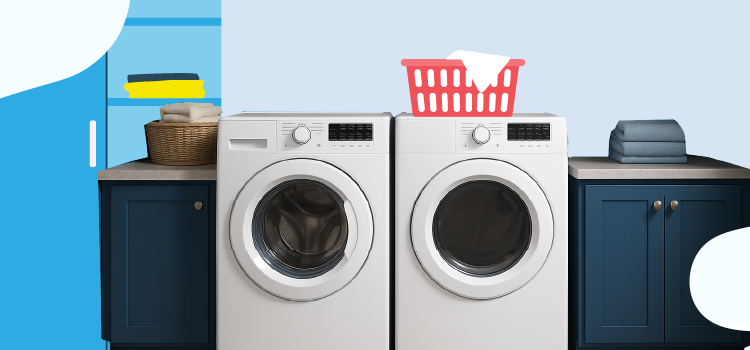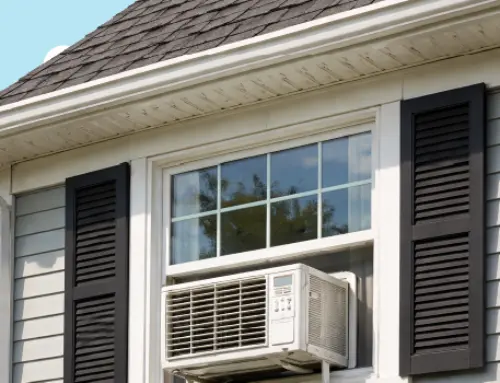How to Tell if Your Dryer is Gas or Electric
by Tyler Castle
18.7 min read

When it comes to home appliances, the dryer often flies under the radar, until your energy bill spikes, your laundry takes forever to dry, or you’re moving into a new home and staring at an unfamiliar plug. But here’s the thing: knowing whether your dryer is gas or electric can have a real impact on your energy costs, safety, and the kind of utility service you need.
Not sure what kind of dryer you have or which one’s right for your setup? Keep reading. We’ll show you how to identify your dryer type step by step, compare energy costs, and make smarter choices about the energy flowing through your home.
Key Points of This Article:
- Gas and electric dryers differ mainly in their heat source. Gas dryers use a burner fueled by natural gas or propane, while electric dryers rely on a heating coil powered by a 240-volt outlet.
- You can identify your dryer type by checking the plug, looking for a gas line, inspecting the appliance label, or reviewing your utility bill. Electric dryers use large plugs and no gas line, while gas dryers use standard plugs and have a visible gas connection.
- Gas dryers are generally more energy-efficient and cost-effective in areas with low natural gas rates, but they require professional installation and proper venting; electric dryers are easier to install and better suited for homes without gas service.
- Safety is crucial for both types. Clean the lint trap regularly, inspect vent ducts annually, and ensure proper installation to avoid fire risks, carbon monoxide buildup, or electrical hazards.
What Are the Differences Between Gas and Electric Dryers?
Gas and electric dryers might look nearly identical on the outside, but they operate quite differently behind the scenes. Understanding these differences can help you make smarter choices about appliance upgrades, energy usage, installation costs, and home safety.
Here’s how they’re different:
Heating method
The most important difference between gas and electric dryers is how they produce heat.
Gas dryers use a gas burner that ignites natural gas (or sometimes propane) to create heat. In contrast, electric dryers use a metal heating coil that warms up when electricity passes through it, similar to the way a toaster or electric oven works.
While both types of dryers use a motor to tumble clothes and a fan to circulate air, the heat source is what sets them apart. Because gas burners heat air faster, gas dryers typically warm up more quickly and may dry clothes in less time.
Hookup requirements
Gas and electric dryers also differ in what kind of hookups they need to work properly.
A gas dryer requires a natural gas line and a standard 120-volt electrical outlet for basic functions like the drum motor, timer, and ignition system. It also needs proper outdoor venting to safely remove exhaust gases and moisture.
On the other hand, an electric dryer requires a 240-volt outlet which is much larger than a regular plug, to handle the energy demand of its heating element.
While gas dryers often require professional installation due to the gas line connection, electric dryers are typically easier to plug in and set up if the proper outlet is already available.
How to Tell If Your Dryer Is Gas or Electric
Wondering how to tell if your dryer is gas or electric? We’ve got you covered with all you need to know.
Here’s a simple step-by-step guide to help you confidently identify what type of dryer you’re using, no special tools or technical background required:
Step 1: Look at the Plug
The easiest way to tell if your dryer is electric is to check the power cord and outlet. Here’s how to tell which one you have:
- Electric dryers plug into a large 240-volt outlet, which is usually a three- or four-prong plug that’s much bigger than a standard wall outlet. If you find a cord attached to your dryer or pull out your dryer and see a outlet in the wall, it’s likely you have an electric dryer.
- Gas dryers, on the other hand, use a standard 120-volt plug (like most small appliances) because the heat comes from gas, and only uses a small amount of electricity to power its lights and dashboard. You’ll usually see a regular two- or three-prong plug going into a standard wall outlet.
If your dryer uses a big, high-voltage plug, it’s electric. If it uses a regular plug, it’s almost certainly gas-powered.
Step 2: Look Behind the Dryer for a Gas Line
If you’re still unsure, try pulling out your dryer to see what it looks like from behind. A gas dryer will have a flexible metal gas line or hose that connects the appliance to your home’s gas supply. An electric dryer will not have a gas line at all, it will only have a power cord.
If you see both a thick cord and a gas line, it’s gas. All dryers need electricity for the motor and controls, even gas dryers.
Step 3: Check the Appliance Label or User Manual
If you’re still unsure, your appliance manual can be a big help. Most dryers have a manufacturer label on the inside of the door frame or on the back panel. This label will often say “Gas Dryer” or “Electric Dryer,” along with the model number and serial number.
If you still have the user manual or can find it online using the model number, it will also clearly state the energy source. If you don’t have the manual, try typing the model number into Google or the manufacturer’s website for a product breakdown.
Step 4: Look at Your Utility Bills
If your dryer runs on gas, you should see natural gas usage increase during times when you do more laundry, especially in the winter or for large households. If your home doesn’t have natural gas service at all, or your gas usage is always zero then you almost certainly have an electric dryer.
If you see a natural gas charge on your bill even when you haven’t been using any (think, summer time), you probably have a natural gas dryer.
Step 5: Still Not Sure? Consider Your Home Setup
Think about your home’s age and location. Older homes in the Midwest (like in Illinois, Pennsylvania, Ohio, or Michigan) often have gas lines and may come equipped with gas dryers and because of their cold climate, natural gas usage makes more sense.
Newer homes or apartments might be electric-only, especially if there’s no gas line in the laundry area.
If you’re renting and can’t move the dryer or inspect the hookups, ask your property manager or landlord. You can also call your utility provider and ask if your address has an active gas service.
What Does a Gas Hookup for a Dryer Look Like?
If you have a gas dryer or are considering switching to one, it’s important to know what the hookup setup looks like, both for safety and for compatibility with your home’s utility setup.
A gas hookup for a dryer consists of two key parts:
- A gas supply line. This is usually a flexible stainless steel or coated yellow hose connected to the back of the dryer. It runs to a shutoff valve that ties into your home’s natural gas plumbing. This line supplies the fuel that powers the gas burner inside the dryer. You’ll often see a small lever near the wall, this is the shutoff valve, which must be accessible in case you need to turn off the gas supply quickly.
- And a standard power cord. While the dryer heats with gas, it still needs electricity to run the drum, fan, lights, and control panel. So you’ll also see a regular household plug going into a standard 120-volt outlet nearby, just like you’d use for a lamp or toaster.
If you don’t see a gas line or you’re unsure whether your home has gas service at all, you may not be set up for a gas dryer. And if the gas line is capped off or missing, switching to electric might be simpler.
What Does an Electric Hookup for a Dryer Look Like?
Electric dryers have a very different connection setup, one that handles much more power to heat the coils efficiently. An electric dryer hookup includes:
- A heavy duty power cord. Electric dryers require a special 240-volt outlet (not the standard 120V). The plug is large and thick, and depending on your home’s age, it may be either a 3-prong plug (most common in older homes) or a 4-prong plug (most common in newer homes with separate ground wire for safety).
This outlet is typically located a few inches off the floor behind the dryer. The power cord itself is short and heavy-duty, often with a molded black or gray exterior.
2. And no gas line. If your dryer is electric, there will be no gas line or valve attached to the back of the unit. You’ll only see the large power cord and a vent hose that leads to the outside.
Gas vs. Electric Dryer: Which Is Better for You?
Gas dryers are generally more efficient and cost-effective to operate, especially in the Midwest where natural gas rates are lower. They heat up faster and handle large loads well, but they do require professional installation and proper venting for safety.
Electric dryers tend to be easier to install and maintain, especially in homes without gas lines. They’re a good fit for apartments, newer builds, or households using renewable electricity like solar.
For a deeper comparison of efficiency, cost, and maintenance, check out our full guide here.
Tips for Choosing the Right Dryer
Upgrading your system or moving into a new home unsure of which dryer type to choose? We’ve got you! Choosing the right dryer goes beyond price tags and what’s available in stock. It depends on your home’s utility setup, how often you do laundry, your space limitations, and even your energy goals.
Here are a few things to consider before making a decision:
1. Check What Your Home Supports
Already have a gas line? A gas dryer might be more efficient to run. As an added bonus, natural gas is 3.3 times cheaper than electricity so this could pay off in the long run if your house is built to use this energy source.
No gas hookup or live in a rental? An electric dryer is likely your best bet and would be WAY easier to install. Simply plug in your cords and you’re good to go as long as you have the 240 volt outlet to handle the energy consumption.
Thinking about adding a gas line? Be prepared for a big project. Installing one requires extensive work, proper outdoor venting, and professional help to meet safety codes.
2. Think About Laundry Habits
What do your habits look like on a daily basis? If you have a large family or do frequent loads, gas dryers heat faster and can cut drying time. Occasional laundry or smaller loads? Electric dryers will do the job just fine and are widely available.
3. Factor in Energy Costs
Energy prices in your area can make a big difference. In states like Illinois, Ohio, and Pennsylvania, natural gas often costs less than electricity, which can translate to noticeable long-term savings with a gas dryer.
On the other hand, if your home is powered by solar panels or you purchase a clean, renewable electricity plan, an electric dryer may be the better choice. It can help you meet sustainability goals while still providing the performance you need.
4. Consider Ease of Installation
Installation requirements vary significantly between the two dryer types. Gas dryers must be installed by a licensed technician, and they require both a gas hookup and proper venting to the outside.
Electric dryers are generally simpler to set up—especially in newer homes or apartments, since they typically just need a 240-volt outlet. This plug-and-play convenience makes them an attractive option if you want to get up and running quickly without additional installation costs.
Safety Considerations You Should Know
No matter what type of dryer you own—gas or electric—keeping it safe comes down to proper installation, venting, and routine maintenance. While modern dryers are built with safety in mind, overlooking key details can lead to higher fire risks, carbon monoxide issues, or energy waste.
Here’s what every homeowner should know to keep their laundry routine safe and efficient:
- Clean the lint trap after every load. Lint is the #1 cause of dryer fires, according to the U.S. Fire Administration.
- Inspect the vent duct at least once a year. Make sure it’s not crushed, kinked, or clogged with lint.
- Use rigid or semi-rigid metal ducting. Avoid plastic or foil accordion-style hoses, which are more flammable and less durable.
- Keep the area around the dryer clear. Don’t store boxes, cleaning products, or other flammable materials close to the unit.
- Don’t leave the dryer running unattended for long periods. If a problem occurs mid-cycle, it’s best to be nearby to catch it early.
For Electric Dryers:
- Overloading circuits can lead to overheating or electrical fires. Electric dryers need a 240-volt dedicated outlet—don’t use extension cords or plug into shared power strips.
- Old or faulty wiring in older homes may not support high-wattage appliances. Have an electrician inspect outlets and breakers if you’re installing a new electric dryer.
- Lack of venting in electric ventless models can cause overheating or moisture buildup if filters aren’t cleaned regularly.
For Gas Dryers:
- Gas leaks are rare but serious. Always install gas dryers with the help of a licensed technician to ensure the gas line is secure.
- Carbon monoxide buildup can occur if the dryer isn’t vented properly. Gas dryers must always vent to the outside—not into attics, basements, or crawlspaces.
- A carbon monoxide detector is highly recommended near your laundry area to alert you in case of improper venting or combustion issues.
How to Disconnect a Gas Dryer Safely (Only if You’re Sure It’s Safe to Do So)
If you’re moving, replacing your dryer, or doing laundry room renovations, you may need to disconnect your gas dryer. While it’s always safest to let a licensed professional handle gas appliances, here’s how to disconnect a gas dryer safely:
- Turn off Power from Your Breaker Box: As a safety, turn off your electrical supply from your breaker box leading to your dryer so you don’t electrocute yourself.
- Unplug Your Dryer: Start by turning off the dryer completely and unplugging it from the electrical outlet. Even though it’s gas-powered, the motor and controls use electricity.
- Turn Off the Gas Supply Valve: Next, locate the shutoff valve on the gas line (usually a small lever close to where the flexible line connects to the wall). Turn the valve perpendicular to the pipe to stop the flow of gas.
- Test That the Gas Is Off: Wait a few minutes and smell for any gas odor. If you still detect a “rotten egg” smell, do not proceed—call your gas utility provider or a licensed professional.
- Disconnect the Flexible Gas Line: Using a wrench, slowly loosen the nut where the flexible gas line meets the shutoff valve. Be cautious—there may be a small gas release when it first breaks free, but it should stop quickly if the valve is fully shut.
- Cap the Gas Line (Optional but Recommended): You can install a threaded cap or plug over the gas line opening for extra safety. This helps prevent accidental leaks if the valve is turned on later.
- Detach the Vent Hose; Finally, disconnect the dryer vent from the back of the unit. Clean out any lint or buildup while you’re back there!
Important Safety Notes: Never use Teflon tape on gas fittings, only use pipe thread sealant rated for gas if capping the line. If you’re unsure of what you’re doing at any point, stop and call a licensed professional.
Don’t reuse old flexible gas lines when reconnecting a new dryer—use a new line with each installation, per manufacturer recommendations.
How to Disconnect an Electric Dryer Safely
If you’re moving, upgrading your dryer, or remodeling your laundry area, you might need to disconnect your electric dryer. While it’s generally safer than working with a gas appliance, it still involves high voltage and should be done carefully to prevent shock, damage, or injury. Here’s how you disconnect an electric dryer safely:
- Turn Off the Dryer: Like any appliance you’re working with, it’s always a good idea to make sure the dryer is powered off at the breaker box. Do not attempt to unplug or move the dryer while it’s running or mid-cycle. You could shock yourself!
- Turn Off the Circuit Breaker (Recommended): For added safety, especially if you’re working on or around the outlet, turn off the dryer’s breaker in your home’s electrical panel. This helps prevent accidental shock if someone else plugs it in later.
- Unplug the Dryer from the Outlet: Carefully pull the dryer away from the wall just enough to access the plug. If your dryer uses a 240-volt plug (common for most homes), grip the base of the plug firmly and pull straight out. Do not yank the cord or pull from the wire, it could damage the plug or outlet.
- Secure the Power Cord: Once unplugged, wrap the cord neatly and tape it to the back of the dryer so it doesn’t drag on the floor or get damaged during moving or storage.
Important Safety Reminders: Never touch the plug with wet hands as moisture and electricity don’t mix. If you see any signs of damage (frayed wires, scorch marks on the outlet), stop and call a licensed electrician.
Don’t attempt to hardwire or modify a dryer plug on your own and always use the factory-installed cord for safety and warranty protection.
How to Install a Gas Dryer (With a Licensed Technician)
Installing a gas dryer isn’t a DIY job, it involves handling combustible fuel, ensuring proper venting, and meeting local building codes. For safety and code compliance, always hire a licensed technician. Here’s how to you typically install a gas dryer with a licensed technician:
- Verify Your Utility Setup: They’ll check that you have an active gas line, shutoff valve, and the right kind of electrical outlet (usually a standard 120V outlet for gas dryers).
- Install or Replace the Flexible Gas Connector: The tech will install a new CSA-certified gas connector, which safely delivers gas from the wall to the dryer. This part should never be reused between dryers.
- Apply Leak-Proof Thread Sealant: They’ll apply sealant to the threaded fittings and securely attach the gas line to prevent leaks.
- Test for Leaks with Soapy Water or Electronic Detector: Before turning on the dryer, they’ll run a leak test to confirm the line is sealed tight. This step is critical for safety.
- Secure and Vent the Dryer: They’ll connect the vent hose, check for obstructions, and ensure that it vents directly to the outside—not into a crawlspace, attic, or wall cavity.
- Power Up and Test the Dryer: Once connected, the technician will plug the dryer in, turn on the gas, and run a short test cycle to confirm it heats properly and vents correctly.
FAQs
Are gas dryers safe?
Yes, gas dryers are safe to use in homes when they are installed correctly and maintained properly. Millions of households in the U.S. use gas dryers every day without issues. That said, because they use natural gas (or propane) as a fuel source, there are a few important safety factors to keep in mind.
Does a gas dryer have a pilot light?
No. Modern gas dryers do not use a standing pilot light. Instead, they use an electric igniter to light the burner only when needed. This makes them safer and more energy-efficient.
Can I convert my dryer from gas to electric (or vice versa)?
Not easily. Converting a gas dryer to electric—or vice versa—is not recommended and often not possible with most residential models. Each type is built with different heating components and safety systems. It’s safer and more cost-effective to replace the dryer entirely with the correct type for your home’s hookups.
Are gas dryers safe for small spaces or apartments?
Only if properly vented. Gas dryers must be vented outdoors, so they’re not ideal for apartments or small spaces without external venting access. In these cases, an electric ventless dryer (like a condenser or heat pump model) is safer and more appropriate.
Can my utility provider help me determine my dryer type?
Yes. Your natural gas or electricity provider can confirm if your address has active gas service or if you’re being billed for gas usage. If you’re unsure what type of dryer you have, this is a good starting point—especially if you’ve recently moved in.
By now, you’ve learned exactly how to tell if your dryer is gas or electric, just check the power cord, look for a gas line, review your utility bill, or inspect the model label. While they may look similar on the outside, gas and electric dryers operate very differently and can impact your energy costs, home safety, and long-term utility choices.
Understanding what kind of dryer you have is more than just a tech check, it’s an opportunity to make energy-aware decisions that align with your home setup, lifestyle, and budget. Whether you’re doing laundry once a week or tackling a mountain of towels daily, the type of dryer you use affects what kind of energy plan works best for you.
Santanna Energy’s Unlimited Energy Plan gives you the peace of mind of predictable billing, with no surprises in your supply charge, whether you’re drying one load or ten.* It’s built for Midwest homes like yours and backed by customer-first support. Explore your energy options today and take the guesswork out of your laundry routine.
* Restrictions apply. Enrollment based upon program eligibility. Customers using more than 125% of normal monthly usage as determined by Santanna may be required to switch plans.
Tyler is an experienced energy professional, having worked for Santanna Energy Services, for the past four years. He is passionate about renewable energy and believes that diversifying the energy grid is the key to a sustainable future. Tyler is dedicated to supplying consumers with the best possible energy solutions and works diligently to make sure that Santanna can deliver the highest quality service.







